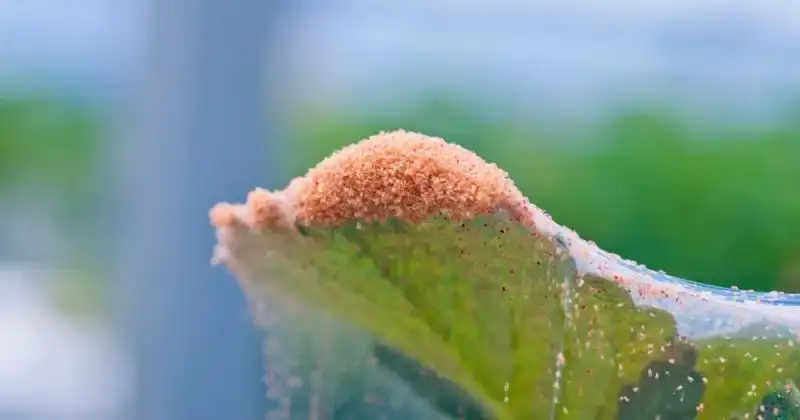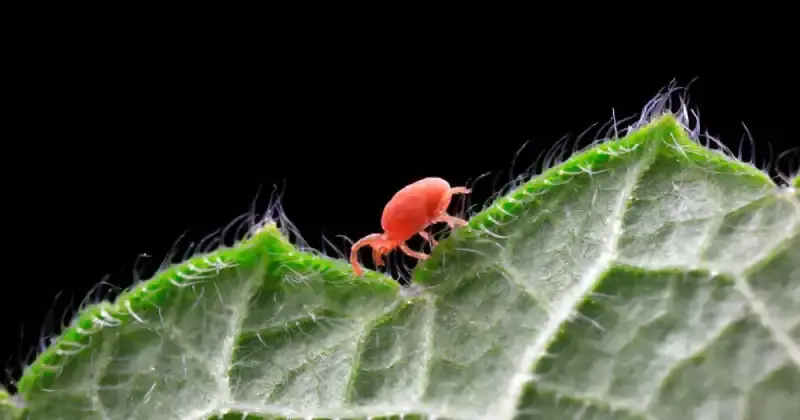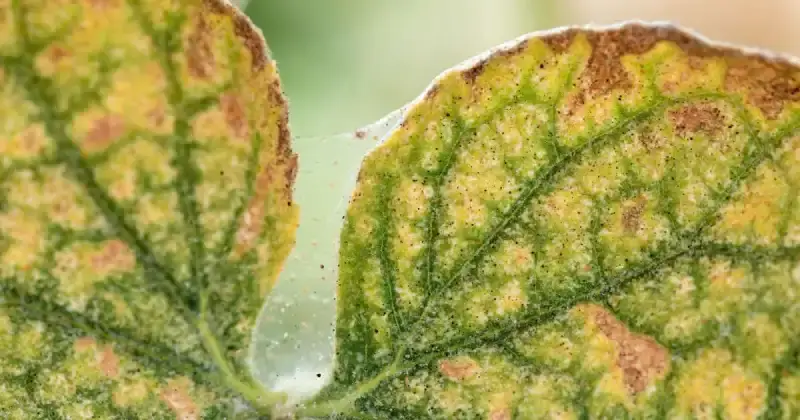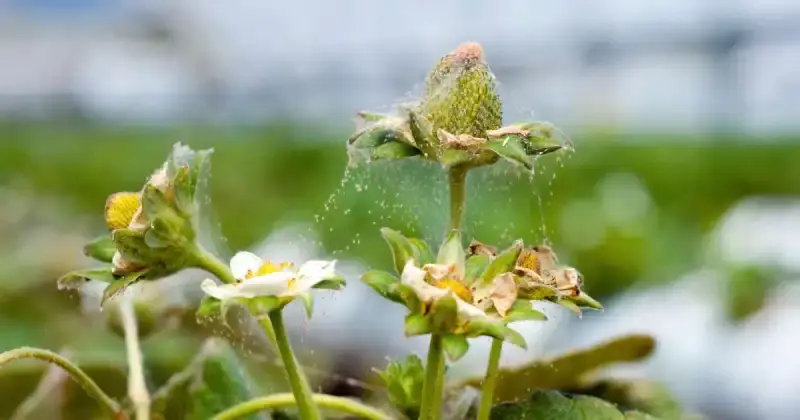How to get rid of red spider mites on my veggies is an age-old question many gardeners have asked themselves. And while red spider mites are opportunist pests lurking in vegetable gardens everywhere, the situation turns stressful once these tiny insects begin feasting on your precious plants. So, as the primary caretakers of our green spaces, let’s take back our green turf and learn how to beat these little mites before they can completely overrun your edible Eden.
The best way to get rid of red spider mites is by removing heavily affected plants from your garden, improving soil humidity conditions, and applying control agents like insecticides and miticides when necessary. You can also add repellent plants like lemongrass, cilantro, and rosemary around and throughout your growing space that naturally and holistically fends off spider mites.

Nothing can be more heartbreaking than when a ton of spider mites stake a claim in your home garden. But we will draw a line in the dirt with our spade because you won’t let that happen.
Natural and organic pest control methods help backyard growers eliminate invading spider mites while supporting your garden and local environmental ecosystem. In this article, we will talk about getting rid of spider mites and how to apply practical prevention and treatment methods to give you the upper hand.
Humble Highlights
- Seize the opportunity to hone your gardening skills so you can learn these simple yet effective natural and synthetic methods to treat your mites and reclaim your turf!
- Save money by knowing precisely what broad-spectrum insecticide spray to purchase so you never again have to stare blankly at that big wall of chemical doom at your local box store.
- Discover which beneficial plants, herbs, and insects you can grow and invite into your garden so you can stop spider mite colonies BEFORE they destroy your growing space.
- Learn the one breakthrough garden secret that helps determine if you have a mite issue so you can gain peace of mind.
What Are Red Spider Mites
Red spider mites are tiny mites around 0.5 mm (or smaller) that attack the leaves and flowers of indoor and outdoor plants and are one of the most common and invasive garden pests you may encounter. However, contrary to their name, they are not exclusively red and come in a rainbow of colors. The two types of spider mites are the European spider mite and the Southern spider mite, with the latter destroying a wider variety of plans.

Although small, identifying these pests is quite easy as they are relatively bright in color and leave behind an equally bright stain when crushed under your thumb. These mites have tiny, oval bodies and are commonly found crawling on garden vegetables, inside house plants, and hedges. 1
What makes red spider mites so destructive and dangerous to your vegetable plants are their unique mouthparts that pierce the plants’ leaves and stems to suck out the sap and moisture. This “sucking” process leeches moisture, making the leaf appear dusty or stippled, and is a dead ringer that mites are presently within your growing space. In addition, these pests enjoy feeding on young, defenseless, sprouting plants that dry out the quickest when exposed to the sun since their root structures are still developing.
But whether you have encountered mites or not, I’ve discovered some great additional Identification and Control Information regarding spider mites distributed by the State of Maine. They’ve thoughtfully compiled several excellent resources from cooperative gardening extension programs across the country on how to identify and combat these menaces.
Generally, mites love dry and dusty soil and typically appear in spring and fall, yet are most prevalent during summer. Aside from literally sucking your veggie plants dry, they are incredibly invasive, as each female mite can lay dozens of eggs daily. And as their numbers swell exponentially, so does the rate at which they can decimate your garden, making for a mighty challenge if not addressed adequately.
Identifying Signs Of Red Spider Mite Infestation In The Vegetable Garden
You can identify spider mites by their size and bright color. As the name implies, red spider mites may be bright red, yet can also be bright yellow, brown, and even green. Mites leave a distinctive webbing around the stems and underside of leaves of your vegetable plants, along with small yellow or white spots where they’ve pierced the plant. With larger infestations, you may also notice slight or severe “tanning,” bronzing, or a general rusty color hue of the plant’s leaves.

There are two common spider mite pests that gardeners encounter. One is a two-spotted spider mite, also called the European mite, and the other is the spruce or Southern mite. While the European mite thrives in hot and dry conditions, Southern mites wreak havoc within cooler environments.
In any case, if you suspect that red spider mites have now declared your garden their home, it’s good practice to closely observe the leaves of your plants to confirm that they are indeed mites causing the damage. Remember, proper observation and identification of garden pests is an excellent quality of any good gardener, and searching for mites is no different. 2
Apart from noticing small, walking ovals with tiny legs running amok in your garden and on your precious vegetable plants, there are two great ways to immediately identify if you have a red spider mite infestation.
One way is to place a piece of dark fabric or black construction paper behind your plant. If you see tiny white webbing surrounding the stem of your plant or around your leaves, it’s a sure bet spider mites have set up camp.
The other way to identify mites is by taking a white piece of printer paper and placing it under your plant or the individual leaves while simultaneously tapping the plant. Jab your plant long enough, and soon you’ll find lots of red dots crawling upon the surface of your paper.
What Damage Can Red Spider Mites Cause In Your Vegetable Garden
If left untreated, spider mite infestations can cause catastrophic damage to your vegetable garden. Because these pests feed on the sap of plants, impairment can range from speckled discoloration to wilting and even plant death, depending upon how large the mite infestation may be. In addition, red spider mites also carry disease-causing pathogens that can transfer throughout your growing space infecting nearby foliage.
Heavy spider mite infestations will likely slow plant growth, especially in younger, more susceptible vegetable plants. As a result, you’ll experience lower crop yields and reduced fruiting in both seed and transplant quality as long as the mite colony is left alone. 3
But it’s not just young plants that mites attack. If their numbers are left unchecked, they can begin to stunt the growth of more mature plants that, before the assault, showed no signs of disease.
Mite damage typically begins on the top of your plant’s leaves in the form of a yellow, shiny discoloration or a spotted appearance. These indicate that mites use your vegetable plant as an all-you-can-eat buffet.
As always, it’s good practice to double-check that mites are present and responsible for the visible damage. Take a good 10X magnifying glass and inspect the underside of the leaves for mites, eggs, and fine webbing.
Common Plants Red Spider Mites Attack
Red spider mites are attracted to specific secondary metabolites (metabolic processes) and particular aromas produced by plants. Therefore, it’s common to see mites completely decimate one garden plant species while leaving another nearby crop untouched.
Below are some common vegetable plants that mites tend to gravitate towards. If you grow any of these varieties in your garden, you must keep an extra protective eye on your crops.
- Cucumbers
- Tomatoes
- Peppers
- Lettuce
- Peas
- Beans
- Eggplant
- Zucchini
- Squash
- Mellon (cantaloupe and watermelon, for example)
- Strawberry
- Blackberries
- Peaches
- Fruit Trees
The video below provides a wonderful explanation of how you can care for your vegetable plants when facing red spider mites. Remember, these invading pests are among the most damaging problems you will ever encounter in the garden.
Conditions Red Spider Mites Love
Red spider mites are attracted to light, heat, and dry environments. If your climate supports this trifecta, be on the lookout. Mites also enjoy inhabiting dry potted soil, so be sure you don’t have a random pile in your garden. It’s best to move this dirt as far away from your garden as possible. Additionally, when you’re ready to use the soil in the garden, use caution so you don’t inadvertently transfer any mites that may be residing within.
Mite colonies also commonly congregate across stone or brick structures and walls, especially on the south side of your property. And if your backyard garden is situated near these structures, there’s a better chance spider mites will migrate into your garden.
If you find spider mites crawling on any exterior structure near your garden, move any vegetation at least 4 to 6 feet away. You can also consider placing a gravel barrier between the colony and your garden beds, making it more difficult for mites to traverse.
What Is The Best Solution To Treat Red Spider Mites
You can use many solutions in treating spider mite infestations, from natural options to synthetic pesticides. For example, a quick and inexpensive way to temporarily remove spider mites from your vegetable plants is by spraying water to dislodge the pests while keeping your garden soil moist with drip irrigation to discourage their re-occurrence.

Effectively treating red spider mites in your vegetable garden generally comes down to how expansive the infestation has become. While keeping your garden moist may help prevent future mite damage, it does little to stop the mites already colonizing your space. 4
Suppose the population has grown so big that mites are attacking multiple vegetable plants in your garden. In that case, lower toxicity miticide sprays will likely need to be used over several applications.
You can also explore several alternative solutions that can treat spider mites. Most of these options are applied repeatedly to the plant body and leaves for several weeks to ensure that red spider mites are treated appropriately.
Here are some common steps you can start taking today to begin treating mites in your garden.
- Remove affected plants and discard fallen leaves from your garden immediately. If the surrounding plants aren’t yet mature, consider moving them to another area within your garden by carefully preserving their root structure during the transfer.
- Release predatory mites, lacewings, or ladybugs into your garden. If you choose this option, avoid applying broad-spectrum insecticides, as they will also target these beneficial insects.
- Use isopropyl alcohol. Apply 70% of isopropyl alcohol and lightly spray your plant’s leaves and stems. Be sure you use this spray sparingly, as it can leach into your soil, where it may be absorbed by your plants, causing dehydration and death.
- Apply DIY soap solution. Use 3 tablespoons of regular dish soap to 1 gallon of lukewarm water. Pour into a bottle and spray the plant stem along with the top and bottom of the leaves.
- Consider Neem oil. This organic and non-toxic insecticide won’t harm your plants or beneficial predatory insects. When applied, it covers and smothers the eggs and mites alike.
- Rosemary, Spearmint, and Coriander oil. When applied generously, a few drops of one of these natural oils and water stifle and repel red spider mites.
- Eucalyptus, Thyme, and Lavender oil. These oils provide an alternative to harsher chemical and pesticide use. However, it’s best to apply these plant oil extracts sparingly.
Remember, prevention is the best remedy for combating spider mites. Therefore, creating a moist and well-watered environment provides an excellent start. Likewise, inviting predatory insects into your garden, like ladybugs or lacewings, will show those mites a thing or two by keeping their numbers manageable.
Vegetables And Herbs That Fend Off Red Spider Mites
Another organic way to help prevent red spider mites from visiting your garden is planting vegetables and herbs they don’t enjoy. Your best bet is to grow herbs and vegetables from the Allium family, like chives, shallots, garlic, onions, and scallions. These plants contain natural miticidal components that commonly repel mites.
Additional beneficial choices you should consider include broccoli, radish, parsley (especially Chinese parsley), dill, peppermint, lemongrass, rosemary, and cilantro.
You can either plant these herbs and vegetables throughout your garden beds or do what I do and grow a few in pots where they can be quickly and strategically moved and rotated throughout your growing space all season long.
Deploying Predatory Mites And Insects To Get Rid Of Red Spider Mites Naturally
When first detecting spider mites in your garden, so long as the infestation isn’t rampant, consider using natural methods first to help preserve your garden and your surrounding ecosystem. For example, putting Mother Nature to work by using beneficial bugs like predatory mites, lacewings, and ladybugs can help you curb spider mite numbers and help get your growing space back in order.
However, for these beneficial bugs to stick around, you must create the ideal garden environment to make them content. After all, the last thing you want is for them to fly off to greener pastures and work hard in someone else’s yard.
How To Get Rid Of Red Spider Mites
Getting rid of spider mites is a multi-application process. Because you’ll want to ensure you’ve eradicated the entire colony and multiple generations of mites within your garden, selecting natural options is a good choice. However, if organic alternatives aren’t providing relief, rotate through two to three synthetic sprays with contrasting ingredients to target the mites differently so they don’t build up a tolerance to just one.

When treating mites in your space, it’s always best to begin with natural treatment options as it conserves the surrounding environment and your garden. For example, spraying water on your plants, mainly the underside of the leaves dislodges mites from your crops.
Removing and isolating any plant or debris from your garden that may be mite-infested is also standard practice. Finally, so long as the mite colony isn’t too invasive, predatory insects like the beneficial ladybug can help keep mite numbers low and manageable. 5
If the above holistic solutions don’t provide relief, then other methods should be applied to curtail their numbers.
A word of caution, however, before spraying any mite-killing pesticide within your garden space. No matter how benign the label may state the product is, it’s always good to spray conservatively. These broad-spectrum insecticides will harm more than just the mites you are targeting. They will also target necessary pollinators like honey bees, butterflies, and other beneficial insects – like those that prey on red spider mites.
However, if you decide to move forward and use chemical sprays, the best time to apply them is at dusk, when most of these good insects have called it a night.
I found this video on YouTube that helps you choose what treatment method is suitable for you depending on how severe your spider mite issue is. While you can solve your mite issue with natural treatments as long as you catch it early, if the infestation is more substantial, you’ll need to decide if a synthetic option may be a more realistic course of action.
Insecticidal Soap
Fortunately, most insecticidal soaps don’t leave much, if any, residuals that may harm beneficial insects when they come in contact with the solution. These sprays also usually kill mites on contact, making them an excellent first-line defense within any garden space.
However, because they don’t leave much residue on your plants when applied, most insecticidal sprays aren’t potent enough to challenge large mite colonies. Instead, they aim towards combating smaller, less developed numbers, so it’s best to keep that in mind before using. 6
Miticides
Miticides are also helpful in controlling red spider mites in the garden. Because so many miticide options exist today, the main problem may be determining which one to use. Although not labeled organic, I like Mite-X because it includes natural ingredients of garlic, cottonseed, and clove oil.
When purchasing any miticide, look for the word “caution” on the label, as these brands are the least toxic to your garden’s ecosystem and the beneficial insects it hosts. Remember, just because a spray states it is more toxic for the mites you are trying to eradicate doesn’t mean it will be more effective in the long run.
Oils
Essential oils like neem are great because they target mites in different growth stages, from the egg to the adult female laying them. And because you may have twenty or more mite generations within your garden at any point during the growing season, neem oil comes in handy when trying to eliminate larger mite colonies. And as a bonus, neem oil is also approved for organic gardening, which is why I enjoy using it to ward off mites on my plants throughout the season.
Check Lowest Prices On Bonide Captain Jack’s Neem Oil
Spinosad Based Insecticide Sprays
Although a relatively new option, Spinosad-based sprays, a natural bacteria, is the leading pesticide used worldwide today. Interestingly, Spinosad was discovered by accident in a vacant rum distillery and has been used effectively to treat harmful insects ever since.
There are several varieties of Spinosad, including Captain Jack’s Dead Bug Brew or Monterey Garden Insect Spray, but again, it’s best if you’re looking for something approved for organic gardening. This way, the application is safe for visiting guests and pets you may have strolling through your garden.
Check Lowest Prices On Spinosad Red Spider Mite Sprays
Horticultural Oils
Horticultural oils are another great option for controlling and eliminating red spider mites, as you can use them year-round and even as a preventative during all stages of insect growth. However, if opting for a horticultural oil, I suggest Bonide All Seasons Horticultural and Dormant Oil Spray. Its main active ingredient is natural mineral oil, and approved for organic gardening. 7
Check Lowest Prices On Horticultural Oils
When using any sprays or oils like those mentioned above and the synthetic options below, be sure the active compounds in each spray don’t interact negatively in conjunction with each other. Again, your goal is to eliminate spider mites, not create a toxic environment for your plants.
Synthetics
Perhaps used as a last line of defense, synthetic sprays effectively eradicate large mite colonies when everything else up to this point has yet to bring down their numbers to manageable levels. Unfortunately, organics may not be enough to treat these large invasions because they don’t have lasting residual toxicity, even after multiple applications. Bonide Malathion will be the ideal next step if this describes your situation.
Consider applying this broad-spectrum insecticide using a hose-end sprayer or, if you prefer, a watering can. Much like the organic options mentioned above, Malathion kills mites on contact. However, unlike the above options, this synthetic absorbs into the plant itself, and continues to reside there for about a week. One treatment continues to work on any residual mite that would dare to bite the plant’s leaves.
Check Lowest Prices On Synthetic Sprays For Red Spider Mites
Another common and widely used synthetic is Bonide Eight Insect Control. Again, applying this synthetic leaves a longer residual on your vegetable plants and will significantly help curb your mite population.
Because this synthetic has an even longer residual of about 3 to 4 weeks, it’s best to wait a week or so before harvesting any ripening crops to give the weather and your plant’s internal system a chance to process this chemical.
Check Lowest Prices On Bonide Eight Red Spider Mite Synthetic Spray
Although you can spray synthetics on fruiting vegetable plants, I tend to favor something other than this approach in my garden. I’m much better at preventing these pests before they become a problem, and I encourage you to do the same.
Keep an observant eye on your garden so these pests don’t gain the upper hand. That means creating an environment they don’t like by ensuring you don’t over-fertilize your garden, attract beneficial insects, and growing plants and herbs like onions, garlic, Chinese parsley, dill, and peppermint within your garden.
Over-fertilization, in-particular, is like ringing the dinner bell for spider mites. The excess nitrogen in many household fertilizers can attract mites into your garden, with additional applications only swelling their numbers.
Conclusion
Granted, it may not be your best day in the garden if you realize pesky mites are invading your sacred garden. Even though mites are small, they can completely decimate a thriving garden in a matter of weeks by the sheer numbers of their destructive power. In addition, they thrive in warm, dry conditions and can be challenging to control due to their small size and ability to scurry from plant to plant.
Fortunately, there are plenty of things you can do to fight back and reclaim your garden. The best method is prevention. Planting herbs and vegetables that deter mites is a tremendous first-line strategy while releasing beneficial bugs that prey on mites is another fantastic organic alternative.
Having garden awareness means catching a mite problem early in its development. If mite numbers grow exponentially, you’ll need to use a good rotation of broad-based insecticides to combat their expanding numbers so these pests don’t begin to build up an immunity to any single application.
Because mites are relentless, you’ll find that you’ll need to reapply these sprays over multiple weeks. Again, it’s best to spray at dusk, with no wind or rain, to mitigate the damage these sprays may cause to beneficial insects and pollinators your garden needs to flourish. With a bit of time and a sound strategy, like the options outlined here, you’ll be able to regain your garden in no time and get back to more important things, like growing delicious food.
Have you had spider mites in your garden? What did you use to get rid of them? Meet me in the comments below and join the discussion!
SOURCES
- Wikipedia – Spider Mite
- Britannica – Red Spider Mite Family
- University Of Nebraska-Lincoln, Institute Of Agriiculture And Natural Resources – Identifying Spider Mite Damage And The Species Responsible
- Clemson University, Cooperative Extension Home & Garden Information Center – Integrated Pest Management (I.P.M) For Spider Mites
- Ohio State University, Extension – Spider Mites And Their Control
- University Of Massachusetts Amherst, Center For Agriculture, Food, And The Environment – Two-Spotted Spider Mite
- ResearchGate – Study On Thymus Vulgaris, Lavandula Officinalis And Eucalyptus Camaldulensis Extracts On The Two-Spotted Spider Mite

